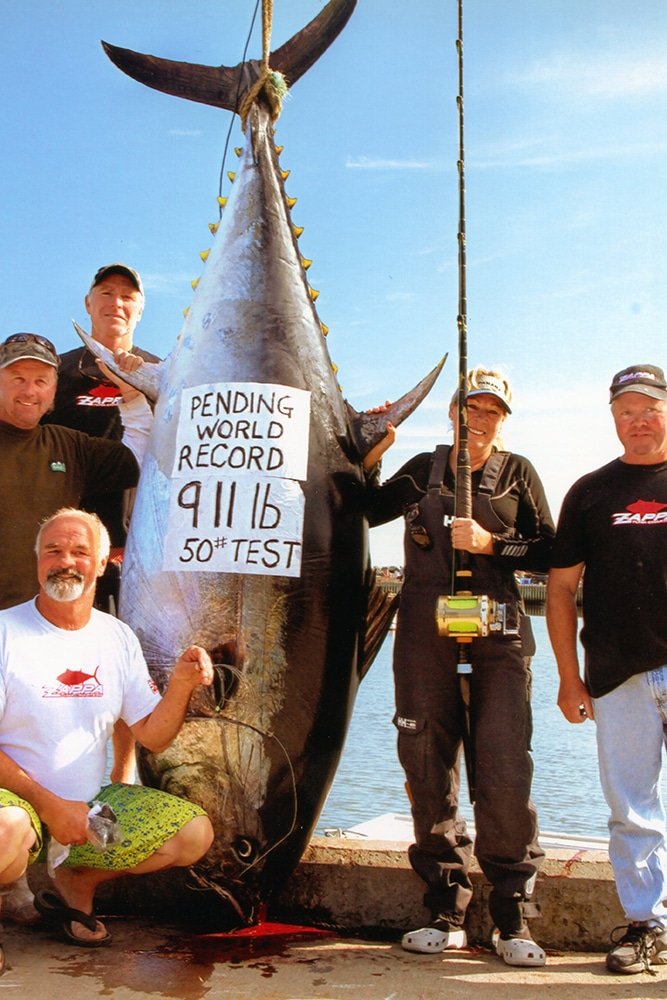The largest Bluefin tuna ever caught weighed 1,496 pounds. It was caught off Nova Scotia in 1979.
Bluefin tuna are among the most prized fish in the world, sought after by both commercial and sport fishermen. These majestic creatures can grow to immense sizes, making them a challenging and rewarding catch. The record-holding Bluefin tuna, caught in Nova Scotia, showcased the species’ potential size and strength.
Anglers dream of landing such a giant, but it requires skill, patience, and the right conditions. Conservation efforts are crucial to ensure future generations can continue to enjoy these incredible fish. Understanding their habits and habitats can help protect Bluefin tuna populations for years to come.

Credit: www.marlinmag.com
Introduction To Bluefin Tuna
Bluefin tuna are one of the ocean’s most magnificent creatures. Their speed, strength, and size make them a favorite among fishermen and seafood lovers. These fish are known for their powerful bodies and impressive migrations across the world’s oceans.
Species Overview
There are three species of bluefin tuna: Atlantic, Pacific, and Southern. Each species has its unique traits and habitats. The Atlantic Bluefin is the largest and most sought after, often fetching high prices at market. Pacific Bluefin Tuna are also highly prized, especially in sushi and sashimi markets. The Southern Bluefin Tuna, found in the southern hemisphere, is similarly valued for its rich, flavorful meat.
Importance In Fishing Industry
Bluefin tuna play a crucial role in the fishing industry. They are one of the most commercially valuable fish species. Fishermen target these giants for their high market prices. In Japan, a single bluefin tuna can sell for millions of dollars. This high demand has led to concerns about overfishing and sustainability.
Here’s a quick look at their importance in the industry:
- High market value
- Popular in sushi and sashimi
- Central to many fishing economies
The bluefin tuna’s significance goes beyond just economics. Their presence in the ocean affects the entire marine ecosystem. Protecting these majestic creatures ensures the health of our oceans.
Historical Record-breaking Catch
The largest bluefin tuna ever caught made history. This monumental catch stunned the fishing world. Anglers and enthusiasts were amazed by its size and weight. The event marked a significant moment in fishing history.
Date And Location
The record-breaking bluefin tuna was caught on October 26, 1979. The location of this historic catch was Aulds Cove, Nova Scotia, Canada. This place is known for its rich fishing waters. The waters around Nova Scotia are famous for their abundant marine life.
Fisherman’s Background
The fisherman who caught the largest bluefin tuna was Kenneth Fraser. Kenneth was an experienced angler with many years of fishing experience. He was known in the fishing community for his skills and dedication. Kenneth often fished in Nova Scotia, where he knew the waters well.
On the day of the catch, Kenneth’s expertise paid off. He battled the giant tuna for hours. His determination and skill led to this historical catch. The bluefin tuna he caught weighed an astonishing 1,496 pounds.
This catch remains a record to this day. Kenneth Fraser’s name is etched in fishing history. His story inspires many anglers around the world. The record-breaking catch of the bluefin tuna is a testament to his remarkable fishing skills.
Details Of The Catch
The largest bluefin tuna ever caught is a fascinating story. This incredible fish broke records and amazed fishing enthusiasts worldwide. Let’s dive into the details of this astonishing catch.
Weight And Measurements
The bluefin tuna weighed an astonishing 1,496 pounds. It measured a jaw-dropping 12 feet long. This massive size made it the largest bluefin tuna ever recorded. Below is a table summarizing the key measurements:
| Attribute | Measurement |
|---|---|
| Weight | 1,496 pounds |
| Length | 12 feet |
The fish’s girth was also impressive. It had a circumference of 8 feet. These measurements highlight the bluefin tuna’s remarkable size.
Fishing Techniques Used
The anglers used advanced fishing techniques to catch this giant. They employed a combination of skill and technology.
- High-strength fishing lines
- Heavy-duty rods
- Powerful reels
These tools helped handle the enormous weight and strength of the tuna. The fishermen also relied on their expertise in deep-sea fishing. They knew the tuna’s habits and movements.
Teamwork played a crucial role in this catch. Multiple anglers worked together to reel in the fish. They took turns handling the rod to avoid exhaustion. The process took several hours of intense effort.
Overall, the combination of equipment, knowledge, and teamwork made this record-breaking catch possible.

Credit: www.reddit.com
Impact On The Fishing Community
The largest bluefin tuna ever caught has made waves in the fishing community. This monumental catch has sparked various discussions and reactions.
Media Coverage
The story of the largest bluefin tuna captured headlines worldwide. News outlets featured the impressive catch. Social media buzzed with photos and videos.
- Newspapers: Many newspapers ran front-page stories.
- Television: Fishing shows and news channels covered the event.
- Online Platforms: Blogs and forums discussed the catch extensively.
Reactions From Experts
Experts in marine biology and fishing had various reactions. Some praised the catch; others raised concerns.
| Expert | Reaction |
|---|---|
| Marine Biologist | Highlighted the importance of species conservation. |
| Fishing Expert | Admired the skill required for such a catch. |
| Environmental Scientist | Warned about potential overfishing risks. |
The largest bluefin tuna ever caught has certainly made an impact. From media coverage to expert reactions, this event has left a mark on the fishing world.
Conservation Efforts
The largest Bluefin Tuna ever caught sparks awe and fascination. But, it also raises important questions about conservation. Overfishing has put Bluefin Tuna populations at risk. Conservation efforts are crucial to protect these magnificent creatures.
Sustainable Fishing Practices
Sustainable fishing practices aim to maintain fish populations. They also help preserve the marine ecosystem. Fishermen use techniques that reduce bycatch. This means fewer unintended species are caught. Fishing seasons are regulated to avoid overfishing. Quotas limit the number of fish that can be caught. These measures help ensure Bluefin Tuna populations remain healthy.
Organizations Involved
Several organizations work to protect Bluefin Tuna. These groups promote sustainable fishing and conservation.
| Organization | Role |
|---|---|
| WWF (World Wildlife Fund) | Advocates for responsible fishing practices. |
| ICCAT (International Commission for the Conservation of Atlantic Tunas) | Regulates fishing quotas and seasons. |
| MSC (Marine Stewardship Council) | Certifies sustainable seafood products. |
These organizations play a vital role. They implement policies and raise awareness about Bluefin Tuna conservation. Their efforts help ensure the survival of this species for future generations.
Economic Implications
The largest bluefin tuna ever caught has significant economic implications. This massive catch influences various aspects of the market. It affects the local economy where the tuna was caught. Understanding these implications can provide insights into the broader economic impact.
Market Value
The market value of a large bluefin tuna is substantial. Bluefin tuna are prized in many countries, especially Japan. A single large tuna can fetch millions of dollars at auction. The price depends on the size, quality, and demand. The largest bluefin tuna ever caught can set new records. This can create a ripple effect, influencing future market prices.
Factors affecting market value:
- Size of the tuna
- Quality of the meat
- Current demand in the market
- Location of the auction
Effect On Local Economy
The catch of the largest bluefin tuna can boost the local economy. Fishermen and local businesses benefit from such a catch. It can attract media attention and tourism. This can lead to more business for local shops and restaurants.
Local markets may see increased activity. The excitement around the catch can draw in tourists. This can lead to higher sales for local vendors. The economic benefits can be widespread.
Economic benefits for the local economy:
- Increased income for fishermen
- More business for local shops
- Higher tourism rates
- Media attention and publicity
These factors all contribute to the overall economic impact. The largest bluefin tuna ever caught can have lasting effects. It showcases the importance of bluefin tuna in the global market.
Culinary Significance
The largest Bluefin Tuna ever caught holds immense culinary importance. This prized fish is sought-after in fine dining. Its rich flavor and texture make it a top choice.
Bluefin Tuna In Cuisine
Bluefin Tuna is a staple in various cuisines. Chefs worldwide treasure this fish. It is famous in Japanese cuisine, especially for sushi and sashimi. The fish’s fatty belly, known as otoro, is highly prized. This cut is tender and melts in your mouth.
In Mediterranean cuisine, Bluefin Tuna is grilled or seared. Its robust flavor pairs well with simple herbs. Olive oil, lemon, and garlic enhance its natural taste.
Popular Recipes
There are many popular recipes for Bluefin Tuna. Here are a few favorites:
- Sushi and Sashimi: Thin slices of raw tuna served with soy sauce.
- Grilled Bluefin Tuna: Marinated in olive oil, garlic, and herbs, then grilled.
- Seared Tuna Steak: Coated with sesame seeds and quickly seared.
Each recipe highlights the fish’s unique qualities. The simplicity of these dishes allows the tuna to shine. Its versatility makes it a chef’s favorite.
Future Of Bluefin Tuna Fishing
The future of Bluefin Tuna fishing is evolving rapidly. With technological advancements and regulatory changes, the industry is on the brink of transformation. These changes aim to ensure sustainable fishing practices and protect marine life. Let’s dive into the exciting future of Bluefin Tuna fishing.
Technological Advancements
Technology is shaping the future of Bluefin Tuna fishing. Sonar systems and GPS technology help locate tuna schools more efficiently. This reduces unnecessary fishing, protecting other marine species.
Drones and underwater cameras offer real-time monitoring. They provide valuable data on tuna behavior and habitat. This data helps in making informed decisions.
Smart fishing nets are another innovation. They minimize bycatch and reduce waste. These nets selectively catch Bluefin Tuna while letting other species escape.
Regulatory Changes
Governments worldwide are implementing new regulations for Bluefin Tuna fishing. Fishing quotas limit the number of tuna that can be caught. This ensures tuna populations remain healthy.
There are also seasonal restrictions. These restrictions protect tuna during their breeding seasons. This helps maintain a sustainable population.
Marine protected areas (MPAs) are expanding. These areas are off-limits to fishing. They provide safe havens for Bluefin Tuna to thrive.
The future of Bluefin Tuna fishing is promising. With new technologies and regulations, we can ensure a sustainable future.
Credit: onthewater.com
Frequently Asked Questions
What Is The Largest Bluefin Tuna Ever Caught?
The largest bluefin tuna ever caught weighed 1,496 pounds. It was caught off the coast of Nova Scotia in 1979. This record-breaking fish was caught by Ken Fraser.
Where Was The Largest Bluefin Tuna Caught?
The largest bluefin tuna was caught off the coast of Nova Scotia, Canada. This location is known for its rich fishing grounds.
How Much Did The Largest Bluefin Tuna Weigh?
The largest bluefin tuna ever caught weighed an impressive 1,496 pounds. This massive fish set a world record.
Who Caught The Largest Bluefin Tuna?
Ken Fraser caught the largest bluefin tuna in 1979. He achieved this remarkable feat off the coast of Nova Scotia.
Conclusion
The story of the largest bluefin tuna ever caught is truly fascinating. This incredible catch highlights the excitement of deep-sea fishing. Such remarkable achievements inspire anglers worldwide. Bluefin tuna continue to captivate both fishermen and seafood enthusiasts. Stay tuned for more thrilling fishing adventures and record-breaking stories.

